Carnival From the Ground Up
Photography by Ryan Hodgson-Rigsbee
Text by Martha Radice
Carnival From the Ground Up is a tribute to the people who make New Orleans’ carnival by hand, and who take carnival to the streets on foot. These are the Baby Dolls and the Black Masking Indians, and the new wave of walking and dancing krewes that march independently or strut between the big floats of the uptown parades. These are the gorgeous and glorious maskers who rule the streets on Mardi Gras day. The exhibit celebrates the creativity, community, hard work, joy, and power of making carnival from the ground up.
The histories and motivations of the carnival groups featured in this exhibit are diverse. The deep-rooted traditions of Black Masking Indians express the strength of Black New Orleanian identity, creativity, and resistance to oppression. Masking draws on African masquerading traditions and honors a history of Native Americans’ solidarity with African Americans, especially the refuge they provided to those seeking freedom and their mutual determination to hold on to their culture in the face of settler colonialism and plantation slavery. A place in a tribe must be earned and recognizes leadership, skill, and status in the community. Similarly, the Baby Dolls’ beauty and bravado speak to Black women’s power, spirit, and independence, as well as their sense of fun and pleasure.
Other walking parades uphold different carnival traditions. Krewe du Vieux, for instance, uses absurd and often lewd humor to poke fun at authority, convention, and political figures. Its members join one of its subkrewes by invitation when spaces open up. Some krewes focus on channeling beauty, like Krewe des Fleurs or the Krewe of Goddesses, or play with themes from popular culture, like the Intergalactic Krewe of Chewbacchus or the Rolling Elvi.
A krewe is a social club that organizes carnival activities. It can be small or big, informal or formal, independent or nested as a subkrewe within a bigger krewe. Each has its own ethos and style. The word ‘krewe’ was coined when a group of wealthy white Anglo-American men founded a secret society to present the first formal carnival parade in 1857. The format caught on and more elite white men started krewes. Their float parades and the laws regulating them reinforced racial, class, and gender hierarchies. Only later in the twentieth century did the city’s official parade calendar diversify to include women’s, Black, and mixed krewes.
Because they walk instead of riding floats, the krewes in this exhibit celebrate in ways that hark back to an earlier era of carnival. In the 1800s to 1830s, processions would form around people going to the balls and masquerades of carnival season. Masking in the streets was popular, despite the city’s attempts to ban it. Some twentieth-century walking krewes were founded explicitly to revive street masking in the French Quarter. Walking krewes have multiplied in the post-Katrina years, as people find ever-creative ways to participate in carnival and show they belong to New Orleans.
Old or new, the yearly rituals of carnival hold deep meaning. The people portrayed in this exhibit speak of honoring ancestors, grieving loved ones, delighting strangers, and making magic with friends. As they make carnival from the ground up, they are telling stories, sharing blessings, and grasping joy.
This text and series was exhibited in the streets of the French Quarter during Carnival 2024. For more info about this project and exhibit please check the links below. Thanks
Exhibit Page
Grasping Joy - Project Page
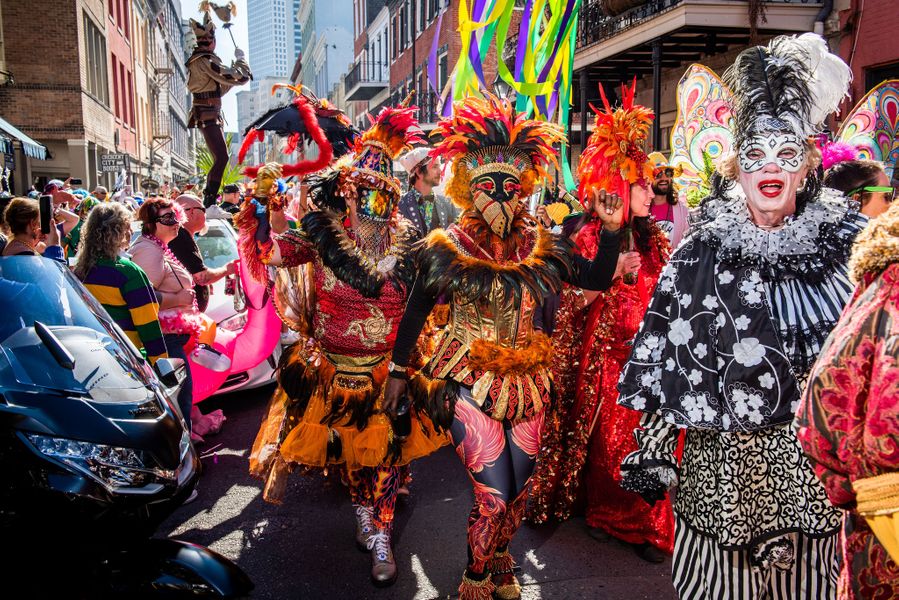
Dressed as phoenixes for Mardi Gras 2022, the Society of Sainte Anne parades down Chartres Street towards Jackson Square on their way to the river. Sainte Anne was founded in 1969 by a group of friends keen to revive the gorgeous, glorious street masking traditions of Mardi Gras past. They remain, as one longtime member puts it, “a very anachronistic, anarchic group with no membership roster, no dues. We are an organic occurrence with a band — once a Secret Society and now the favorite to see on Mardi Gras morning — a group of friends and neighbors dressed in their finest regalia, going for a long walk together.”
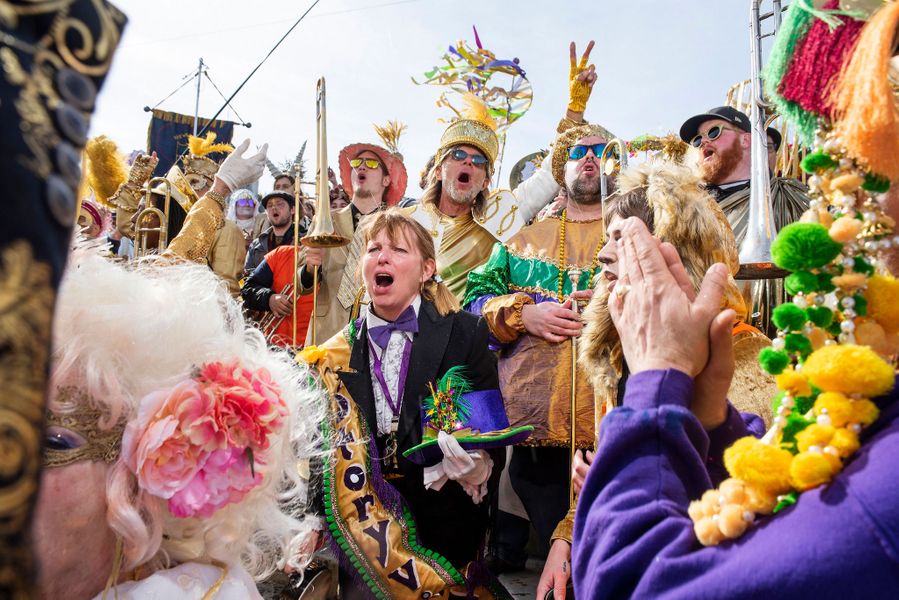
“Some people bring ashes of the dead. Some people bring wishes. My emotion on my face there, that’s me leaving my mother behind. My mother had passed the year prior, and I had gone through the 2018 Mardi Gras, but it kind of hits you, right? A year later. The loss. So that’s what that is. It’s the end of the day, we’ve paraded all the way. That’s several miles. You’re exhausted when it’s done and you’re letting go. That’s a letting go moment right there. When you’re a Grand Marshal, you use your body language. Wesley Schmidt, the longtime Grand Marshal of the band in whose footsteps I follow, never, ever spoke to anyone. Never used his words. Not one. And if he did, it was in a whisper. That body language is a guidance, a God-dance. It’s part of what that photo is all about. People’s body language, people’s feeling is coming through.” Jane Harvey Brown, Grand Marshal of The Storyville Stompers, leads the singing of “Down by the Riverside” as the Society of Sainte Anne reaches the Mississippi River on Mardi Gras day, 2019. The krewe wore gold for their 50th anniversary year.
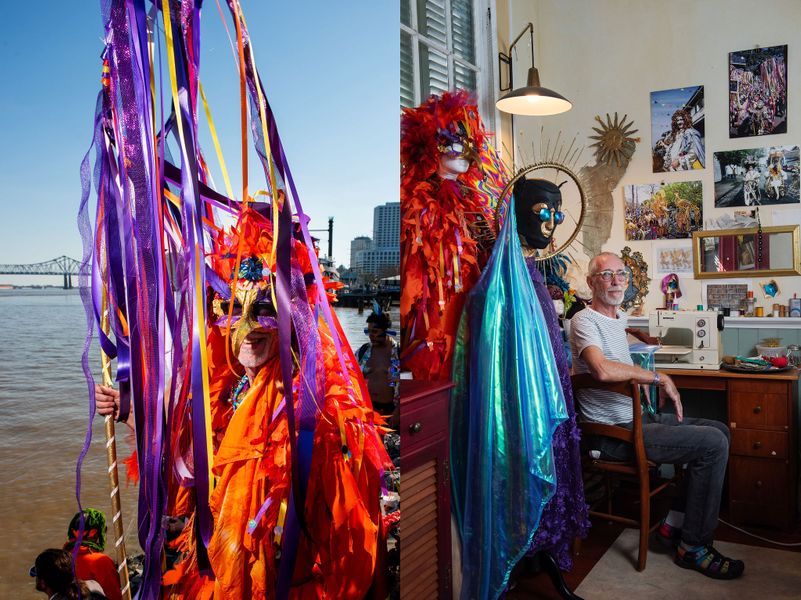
“On Mardi Gras day, we allow whatever magic we’ve been keeping cooped up all year to come out and play with everyone else’s.” Stuart Auld has been parading with the Society of Sainte Anne on Mardi Gras day since the early 1980s. Pictured here as a phoenix in 2022, he often carries one of the iconic ribboned crabnets, which serve to clear the way, salute friends, mark the rhythm of the band, locate the krewe in the crowds, and ripple the waters of the Mississippi as the Society reaches the river. Having worn many hats in the film and hospitality industries, Stuart is now happily retired and able to devote more time to making his fabulous costumes.
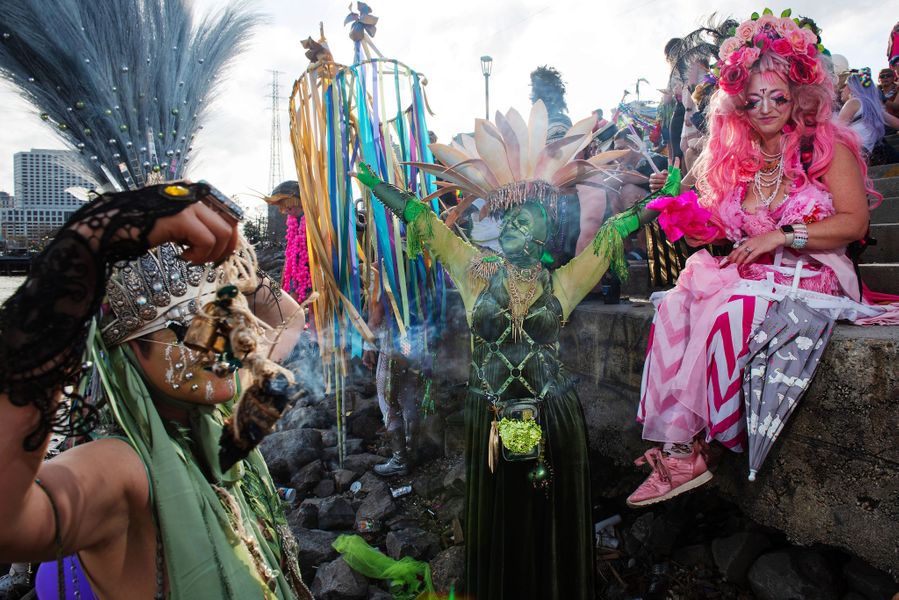
“A few years ago, I had a powerful vision where I turned into a cactus. I felt what it was like to have my whole being be tender green and succulent, yet protected by spiny spikes. When I bloomed, the enormous white flower crowning my head released an intoxicating perfume that attracted gentle pollinators in the night. Those who consume the medicine of this cactus have strange visions themselves — as this plant teacher has the power to unlock the doors to consciousness, and rules the four directions. Later, I identified it as Huachuma (Echinopsis pachanoi), a cactus both delicate and fierce. I loved embodying the succulent, spiky, and potent beauty and magic of the Huachuma, and am really proud of myself for stretching the limits of my abilities as a costumer. It was definitely a social distancing lewk, but I did end up hugging a few brave friends who enjoy a lil ouch from time to time…” Angeliska Polacheck stretches her spines on Mardi Gras day 2023, with her friends Fiona, as Mugwort, and Grace, as Rose. Together, they cultivated the Fantastical Botanical, and walked with Sainte Anne to the river.
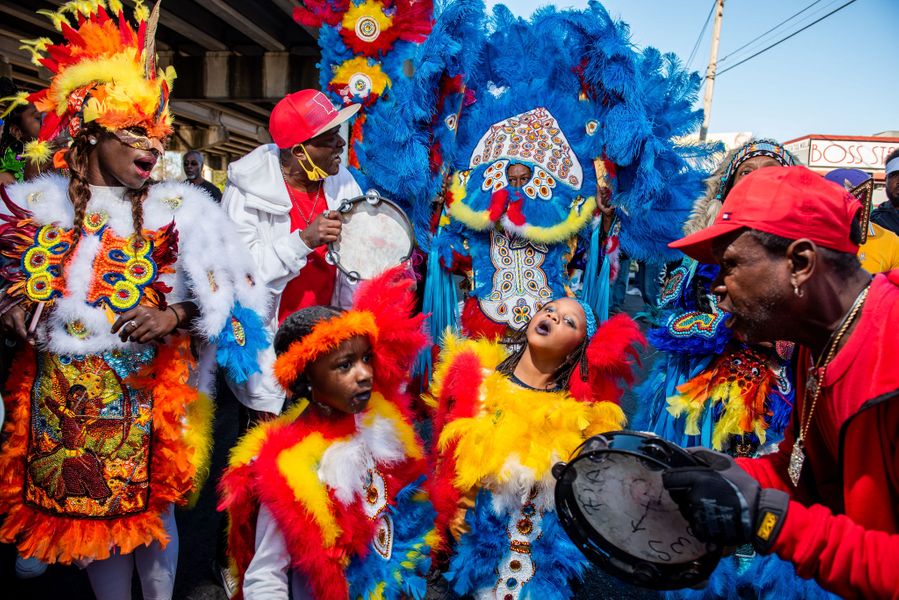
Big Chief Kevin Goodman comes out with his tribe, the Flaming Arrows, on Mardi Gras day 2022. He is in the blue suit, center back, with Big Queen Mecca, left, Bruce Merritt on tambourine on the left, Lil Queen Kay Kay, Lil Queen China singing, and Baka La on tambourine on the right. Big Chief Kevin first masked as a Lil Chief in a stroller in 1960. He grew up in a family deeply immersed in Black Masking culture and is committed to passing it down from generation to generation.
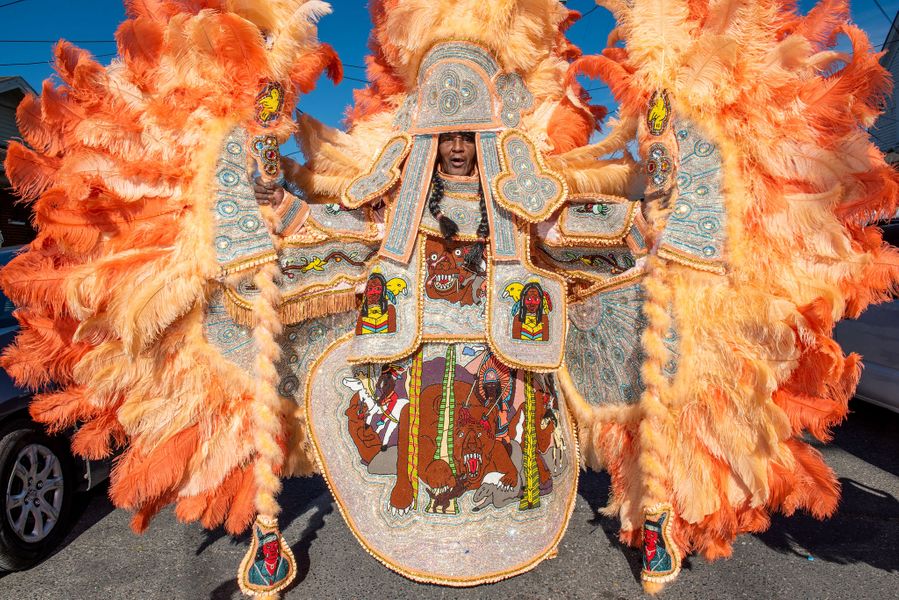
“I have grizzly bears coming through the forest, attacking horses. At that moment the grizzly bears were the predators. But what the grizzly bear didn’t realize, on the back of each one of those horses was the Indian. And the Indians started killing the grizzly bears. At that moment, they became the prey. And the reason why I made that apron is because as you know, I passed my tribe down to my son. But a lot of younger chiefs felt like I was vulnerable, getting too old to stand up. And I was letting them know, when they come over to meet me, they thought they were coming in as the predator, but they were gonna become the prey. I wasn’t finished, I ain’t done.” Cheyenne Big Chief Al Womble comes out on Mardi Gras day, 2022. He started masking at age 8 in 1966, following Cheyenne Hunters. He masked with tribes including the Young Mohicans, Golden Eagles, White Eagles, Gold Star Hunters, 9th Ward Hunters, and Wild Magnolia before returning to Cheyenne Hunters in the early 1990s. He created his own tribe, Cheyenne, in the late 1990s. His wife Wanda became Big Queen, and their sons and grandchildren mask with them. In 2023, Al stepped down from the Big Chief position to become Council Chief to his son Alfred III, the new Cheyenne Big Chief.
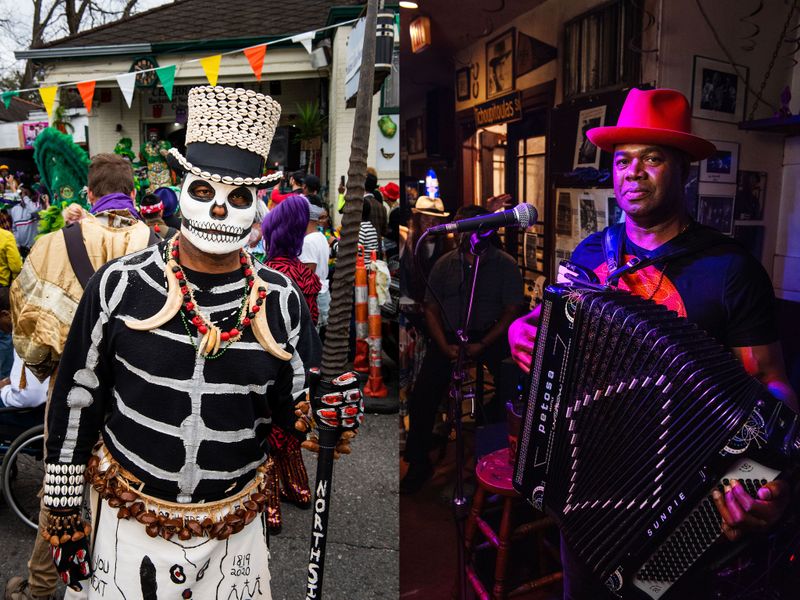
“I’ve played in this bar for 23 years and I’ve masked with the Northside Skull and Bone Gang for 24 years. These have been constants in my life as a musician. For me there’s no separation between those worlds. I would call it community service. It’s medicinal for people in New Orleans to have music in their lives. For people who can’t afford to go to the doctor and lie down and tell them their problems, music is a remedy. Masking with the Northside Skull and Bone Gang is that too. It’s saying, You Next! You can’t buy your way into happiness, you have to generate it from the ground up. You have to make the right choices. It’s the old African narrative: masking as skeletons to show people and remind them where they are headed. Carnival day was the only opportunity that enslaved Africans, especially men, had to express themselves — while having some fun and merriment, but the main thing is to honor the ancestors and bring those messages.” Bruce Sunpie Barnes, Big Chief of the Northside Skull and Bone Gang, on Mardi Gras day 2020. Sunpie and the Louisiana Sunspots play their regular Saturday night gig of Afro-Louisianan music at Dos Jefes, 2023.

“All my suits tell stories. And every child that I teach how to build a suit, I say, make sure your suit tells your story that you want it to say. You don’t always have to be wounded, you don’t always have to be in battle. But you make sure you tell your story. People can help you. Let them help. Help is no problem. Don’t let them do your suit; you do your suit. You are telling the story. And that’s how I come up with all of my suits. But that’s where I come from. Sitting at that table day after day and night after night. I’ve been through a lot. So what I love to do, I’m not gonna stop. I can’t stop. I’ve been doing it for too long and it’s in me.” 2nd Queen Veronica Henry of the Golden Blades sews a patch for her 2023 suit at home, July 2022. She started masking in 1998 with the Wild Magnolia tribe, coming up under Big Chief Bo Dollis, Sr. and Big Queen Rita Dollis. Later, she joined the Golden Blades to walk with 3rd Chief Victor Armstrong as 3rd Queen. They have both since moved up to 2nd Chief and 2nd Queen. Golden Blades has many children masking with them, and 2nd Queen Veronica loves to teach them how to sew and build their own suits and tell their own stories.
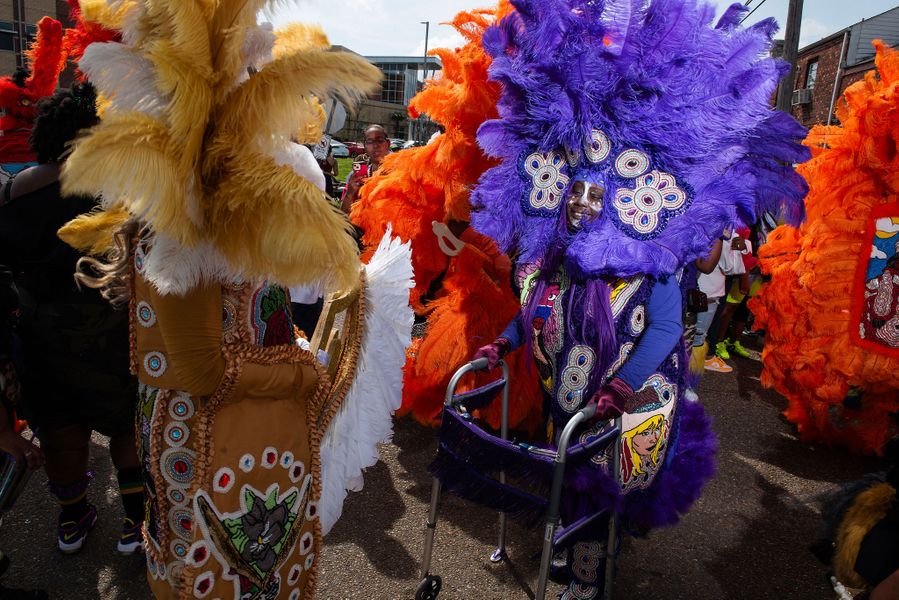
“This suit is the Wounded Suit. This is the story of this suit. The patch you see me sewing in the other photo, that’s the patch on the right side of this suit. She is my warrior woman. The lady at the bottom, that’s what I came from. The feather in the lady’s hat was the color of the last suit that I wore when I was masking on the street, with the burgundy and white. That patch that you see at the top, the lady with the red and the blue, I went from the darkness to the light. I have a wounded feather at the bottom, where my prosthetic leg is at. So, my suit tells my story. But that day I put that suit on, I was so full of joy. I cried. I cried, but I had a feeling like, ‘You did it. You did it.’ I was able to stand and I walked.” Golden Blades 2nd Queen Veronica Henry came out on Mardi Gras day, 2023, after a tough couple of years. While she was evacuating from Hurricane Ida, a foot issue flared up and a bone infection set in before she could connect with her doctor. During post-amputation rehab, 2nd Queen Veronica listened to the music of Bo Dollis, Sr., her original Big Chief, which gave her the spirit to carry on.
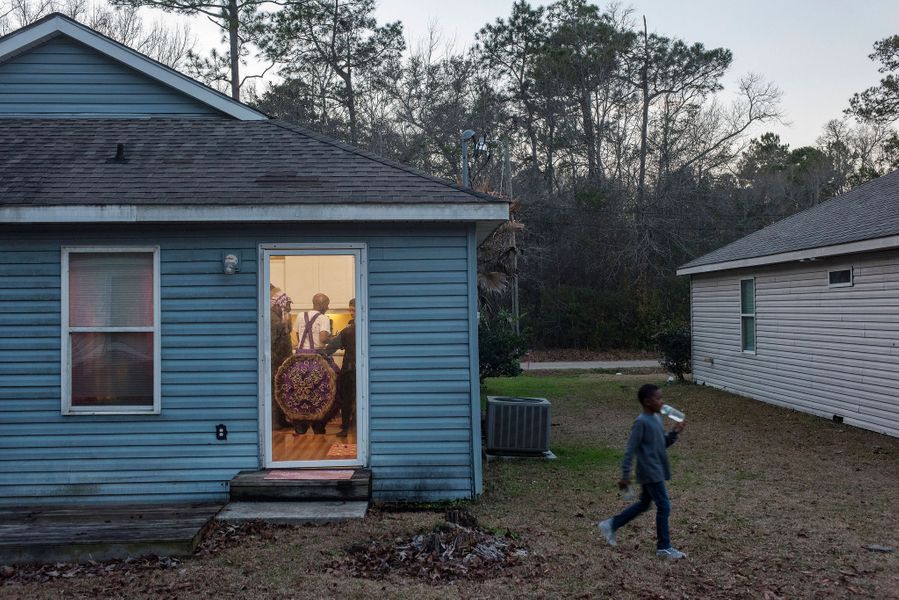
“That purple suit, we were sizing everything up, making sure everything fit and everything was in its right place. Medicine Man Larry started masking because my wife was his cousin, and he had a second line club called Spirit 2 Da Street. I’d never second lined, and one year he said, ‘If you second line with me, I’ll mask with you.’ Since he did that, he’s been masking every year. And I give him back: I mask, and I second line too. My year is full! I have to juggle both of them, the Indian culture and the second line culture. It’s not just sewing — it’s a spiritual thing. When I sit at the table and sew, I sew with all my brothers and sisters that were here, that’s dead and gone. They’re sitting at my table in spirit and saying, ‘Pie, keep going.’ It’s very spiritual. I keep that embedded in me and I keep going because, evidently, I love it.” Monogram Hunters Big Chief Tyrone “Pie” Stevenson works on Medicine Man Larry’s apron at the Chief’s house in Slidell in February 2018. Big Chief Pie is proud to teach the culture the way he was taught it and to keep it going strong.
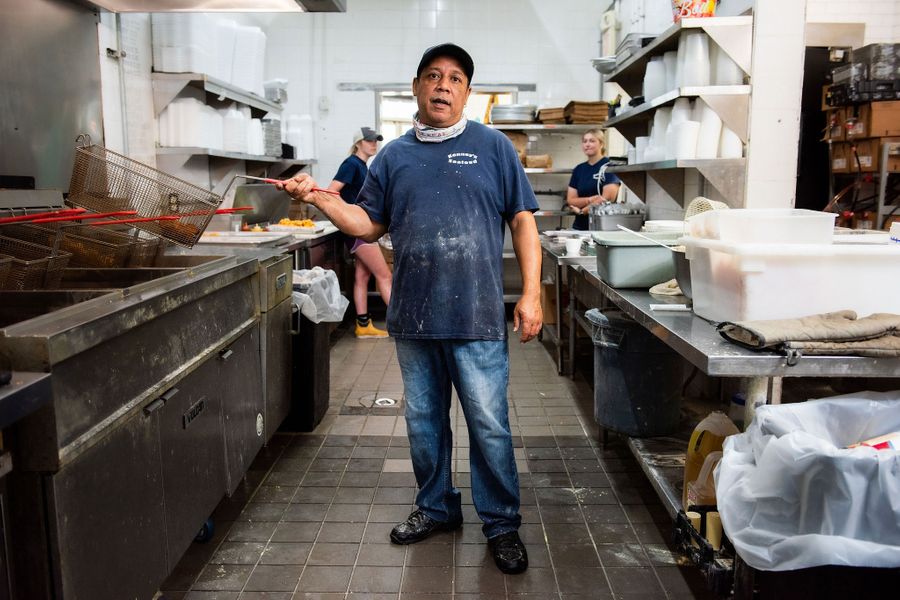
“I was a candy maker by Leah’s Praline Shop. I did that for about 25 years, then I left making candy and I went to cook at Kenny’s Seafood. I worked so hard, and it took a toll, so I said, while I got my spirit and my health, let me retire. So I can keep doing what I’m doing. Hopefully somewhere down the line, God will bless me that with all the years I put in, I get something back. My son Jeremy is second in line, and my goal with Monogram Hunters is to keep it going. But I think I’m gonna do a couple of more years and I really want to retire. Like most chiefs, I want to be able to come out and put a t-shirt on and a pair of jeans on carnival and say, ‘Look what I’ve done that’s still here.’ From another view than putting a suit on. So my blood is still here, and I’m able to see that I did this. That’s what I want.” Monogram Hunters Big Chief Tyrone “Pie” Stevenson works a double shift at Kenny’s Seafood as head cook in May 2021. Pie would work four double shifts a week, then go home and work on his suit.

“When I first started masking, when I was a kid, we all sewed flat pieces. But Tootie Montana gave us the three-dimensional downtown look. And Tootie Montana changed the game of the Black Masking Indians, because he made it about the needle and thread, about the sewing. Tootie taught us that when you are sewing, you concentrate on you, and you have nothing to prove to nobody. The only thing I have to prove is that the suit I put on last year, I have to beat that suit myself. I don’t sew with no other tribe on my mind. I don’t sew with no meeting no certain person. I sew with a free spirit. Whoever you see on Mardi Gras, it’s a beautiful thing. But I’m not looking for them. The competition ain’t with everybody. It’s with you.” Monogram Hunters Big Chief Tyrone “Pie” Stevenson puts on his White Tiger suit with help from his son Tyrone Jr. at his home in Gentilly on Mardi Gras day 2015. Big Chief Pie started masking at age 12 in the early 1970s with Yellow Pocahontas. In 1992, Big Chief Tootie Montana and his brother 2nd Chief Edward Montana gave him their blessing to start his own tribe with the name of their father’s tribe, Monogram Hunters.

“That photo brings back fond memories of me being very excited to see how beautiful my tribe turned out that particular year. Every year coming out on Mardi Gras, it’s still having those same butterflies, still being excited to show off my artwork to all the people that have come out to see it, and being really excited and interested in seeing how everybody else looks outside of my tribe. What we do Is based on culture, but it has a lot of competition in it as well. Me being in it for as long as I have, I think I’ve become a big fan of seeing other people’s work, not only showcasing my own. It’s an honor to continue to pay homage to all of the ones that came before me. Now a lot of those guys have stopped masking and they come out to see me. Just to see the looks on their faces when I come out on Mardi Gras and they get a chance to see the suit for the very first time — it’s honoring, and also humbling. What keeps me doing it? Being called by those drums and those tambourines. It’s hard to put in words, but that calling is almost spiritual.” Big Chief Alphonse “Dowee” Robair with Big Queen Edwina Waterhouse of the 9th Ward Black Hatchet tribe out in their neighborhood on Mardi Gras day, 2019.

“I try to do about four hours a day sewing on my suit. So it definitely takes a lot of time away from other things that you could be doing. And that’s not even to speak about the finances that it takes to pull off one of those suits. That yellow suit in particular, I was right up under $7000. To spend that kind of money to keep culture going for some people would be insane. But seeing my dad and people before him put those suits on and make that sacrifice, I definitely don’t have any problem with sacrificing the time or the money. Those guys often come over here and sit down and sew with me. I do a lot of sewing by myself, but I think I do even more sewing when I have somebody sitting there talking with me and they’re doing the same thing. It’s four or five of us in the same room, just talking about everyday life. It’s not always about Indians, sometimes we talk about sports, or cars, or dogs, or fishing. Just having someone to talk to while you’re sewing, that makes you want to sit there a little longer.” 9th Ward Black Hatchet Big Chief Alphonse “Dowee” Robair, right, sews patches at home with Wild Man Charles “Chuck” Jones, left, and Spy Boy “D”, center, February 2022.
![“Going to the street to meet with my Dolls, I would always run into Fi Yi Yi. We would always have the same color. And I knew that I didn’t tell them what I was wearing and I knew I wasn’t in their Indian camp when they got to the part about the colors. After about four or five years of the same thing happening, Coach [Lewis] stopped me. He said, ‘Well, Cinnamon, you know you really need to be with us.’ I came in as a Baby Doll, and after about five years, I started sewing my own suit. And Chief Victor Harris told me, he said, ‘You make your own suits, you’re gonna be one of my queens.’ Now I’m Big Queen for Fi Yi Yi and the Mandingo Warriors. I grew up here in the city. Culture’s always been a part of my life. I’ve been working in the New Orleans Historic Voodoo Museum since 1980 portraying Marie Laveau. They say I look like her, but I am me and she is she.”
Resa “Cinnamon Black” Bazile founded the Treme Million Dollar Baby Dolls and later joined Fi Yi Yi and the Mandingo Warriors in 2015. She comes out on Mardi Gras morning as a Baby Doll, and by noon changes into her Queen suit to join the tribe, who all wore green in 2020.](/images/tmp.png)
“Going to the street to meet with my Dolls, I would always run into Fi Yi Yi. We would always have the same color. And I knew that I didn’t tell them what I was wearing and I knew I wasn’t in their Indian camp when they got to the part about the colors. After about four or five years of the same thing happening, Coach [Lewis] stopped me. He said, ‘Well, Cinnamon, you know you really need to be with us.’ I came in as a Baby Doll, and after about five years, I started sewing my own suit. And Chief Victor Harris told me, he said, ‘You make your own suits, you’re gonna be one of my queens.’ Now I’m Big Queen for Fi Yi Yi and the Mandingo Warriors. I grew up here in the city. Culture’s always been a part of my life. I’ve been working in the New Orleans Historic Voodoo Museum since 1980 portraying Marie Laveau. They say I look like her, but I am me and she is she.” Resa “Cinnamon Black” Bazile founded the Treme Million Dollar Baby Dolls and later joined Fi Yi Yi and the Mandingo Warriors in 2015. She comes out on Mardi Gras morning as a Baby Doll, and by noon changes into her Queen suit to join the tribe, who all wore green in 2020.

“Everybody in the neighborhood, when it was carnival time, they would be coming by your house to help you sew your suit. No longer anymore. Katrina wiped out the neighborhood, period, and people never come back to where they once lived. But I have to honor my ancestors who once lived in that neighborhood. Everybody’s around there regardless. The spirits of my ancestors are around there. I stop by each one of them’s house in front of their door, the same way I would do if they were living. Because we always stopped and saw the elderly, the sick and the shut-ins. And I’m telling you the truth, there were people that were sick in bed, but when Mardi Gras came, if you go in front of their door, they would get out of their bed. This is the powerful spirit, it makes you rise. It’s religious to us. The culture is all religion. Because our culture is a different society than the society we really live in. Because we weren’t part of society at one time. Society didn’t have nothing for us, so we created our own. And this is what’s so great and powerful about the culture.” Big Chief Victor Harris, Spirit of Fi Yi Yi, sews a patch for his Green Suit six days before Mardi Gras, 2020.

“It wouldn’t be anything if it was just about me; it’s about the people and the blessings that I receive and that I give. I’m a Mardi Gras preacher that morning, so I bless people. And it’s good to see blessings on people’s faces, to see people feeling good about being there, seeing something which they could remember or they could talk about for the rest of their lives. It’s just a joyful feeling for me. Honestly, I love to do what I do and it’s a blessing for me to be out there. It’s not just a thing of just being in a party or a parade. This is a spiritual culture, for myself — I can’t extend this for everyone else, but for me, I’m ordained by the Lord. That’s my given spiritual cultural name, the Spirit of Fi Yi Yi. And I go out there and I try to help other people feel better about themselves. But in a spiritual way and a joyful way, where people could have a good time.” The Spirit of Fi Yi Yi, Victor Harris, Big Chief of the Mandingo Warriors, wears his Green Suit on Mardi Gras day 2020.

“Every ten years, I do a Black Suit: ’84, ’94, 2004, 2014, 2024. This is the fifth coming of the beginning of the ending of the Spirit of Fi Yi Yi. Mardi Gras day 2025, I will be motivating people, doing things to help others, to present my son, who is going to take over the tribe. To help out, to make it even more exciting! I’m thinking about getting my own drum section for my son. I want him to be as powerful as his father. Knowing the drums are there, it’ll help him a lot. So I’ll be there, providing the spirit and all the excitement, still, yet, you know. And helping others.” Big Chief Victor Harris makes his last suit at home in December 2023, for Mardi Gras 2024. He started out as a 15-year-old Flag Boy with Big Chief Tootie Montana’s Yellow Pocahontas. In 1984, he became Fi Yi Yi and founded the Mandingo Warriors, honoring his African ancestors and drawing on the art of African masquerading. The collectively authored book Fire in the Hole: The Spirit Work of Fi Yi Yi and the Mandingo Warriors (Neighborhood Story Project, 2018) tells their story.

Krewe de Lune parade in Krewe Bohème’s 2023 parade, on the theme “Night of the Living Art.” Founded in 2009, Krewe de Lune creates stellar puppets, costumes and contraptions to delight parade watchers, as well as hosting their annual Space Ball and Lunar Lagniappe fundraiser.

The Merry Antoinettes parade through the French Quarter in 2023. The Merrys are one of the krewes that founded Krewe Bohème in 2019, though they also lavish the opulence of the 18th century French court on events in New Orleans all year round. Their motto is “Let them throw cake!”

“I am cuckoo for rococo; that’s my favorite period as a professional costumer. And because it’s Mardi Gras, I can take the historical style and bust it open with sparkly, modern things! There is a light-up squirrel in my wig. I look goofy as hell, but you can see in my smile that I’m happy, fully comfortable in what is kind of an uncomfortable costume. My studio is a happy place too; it’s like walking into my brain, full of chaos and order and beauty. I like to share tips and techniques with the other Merrys. The more they know, the bigger and better their costumes can be. Parading is crazy, especially the walk through the French Quarter. It is a powerful high. I think it’s probably centuries of the spirits of New Orleans taking over. It’s magical.” Monique Motil paraded with the Merry Antoinettes in a group tribute to artist Louis St. Lewis in 2023, when Krewe Bohème’s theme was “Night of the Living Art.” She creates costumes of all kinds at The Queen’s Needle.

The Krewe of Dystopian Paradise parades as “Dystocean Paradise” in Krewe Bohème, 2022. Founded in 2014, the Krewe of Dystopian Paradise embraces the values of irreverence, revelry, beauty, expression, absurdity, community, and kindness. They also roll in the Intergalactic Krewe of Chewbacchus and join Sainte Anne on Mardi Gras day.

“After a few years running a Mardi Gras business, I felt like I needed a different creative outlet, something that’s not bound by someone else’s guidelines and under someone else’s approval. Bri Whetstone, one of the founding members, invited me to join Krewe Bohème in its first year. It happens when I’m so busy that it’s more work on my plate, but weirdly refreshing and energizing, and it helps to get me through. Pulling out a glue gun is so satisfying after sewing meticulously for days and days! We open up the parade, we are like the jesters of the court that come before the royalty. And bubble guns are where it’s at — people get so excited for bubbles. I load myself down with as many bubble guns as I can carry, and when they run out, I give them to the little kids on the route.” When Krewe Bohème’s theme was “The Soaring 20s” in 2020, Katie Johnson, pictured with Bryce Karadon, Bri Whetsone, and Ruby Troyano, flew through the streets as Amelia Earhart. Krewe Bohème gives Katie a jolt of creative energy during her busy season dressing Mardi Gras royalty at her company, Royal Design House.

“I think I got my first sewing machine when I was five or six. I grew up out in the country sewing on my grandmother’s lap, so making costumes has been in my bones from an early age. Whenever I found this niche in New Orleans it was a perfect place to express that creativity, and this business in particular was the perfect mesh of fashion and costume design. We design and create custom gowns and costumes for the kings, queens, and courts of carnival krewes. This is a skirt panel of the ball costume for the King of Rex that I’m sewing — the first new design for Rex since the ’80s. He only gets a new costume every 10 or 15 years, so we’ll make it a certain size and then build in adjustable elements. I looked everywhere for a gold fabric that would snag as little as possible whenever you combine it with rhinestones. The previous costume we were constantly patching because it was always snagging!” Katie Johnson sews Rex’s new ball costume, which took a year to make, in 2018. Katie learned carnival couture under her predecessor Ilaine Hartman. She set up Royal Design House with Ashley Sehorn to continue the craft.

“An election had just ended and there were plastic signs all over the city. My neighbor April Poolson thought, that is some good house float making material right there for free! So we went running round one night picking up old election signs, piled them all in the trunk, and cut them up to make over 130 flowers. It was a really nice project to work on because it was in those months of not knowing if Mardi Gras was going to happen again, not knowing what was going to happen with my business, not knowing if I could afford to keep my employees on. So, so stressful. It was nice to be able to have a project, a distraction, that still contributed to the spirit of Mardi Gras.” In 2021, when parades were prohibited due to the Covid-19 pandemic, New Orleanians improvised a new carnival form by decorating their houses as floats. Here, Katie Johnson airbrushes flowers in her backyard for her house float. Flowers like these often grace the floats of the parades that roll along St. Charles Avenue.

“That yellow house has four apartments, and then the house next door is very similar and is painted a bluish-gray color. We all shared a backyard; it’s a really cool community, and it was really nice to have that community through Covid. So, we knew we wanted to do something together, and make it be like a tandem float, with flowers and papier-mâché props. Being across the street from Poydras Home, we kept it light and uplifting and went with a day and night theme. The other house had a big moon and stars on it. Together, we were House of Sol and Luna. It was fun to do papier-mâché again, because I’ve just been working in fabric, fabric, fabric for years, so it was nice to play around with those materials again.” Katie Johnson and her neighbors made their house floats on Magazine Street Uptown in 2021, when carnival parades were canceled due to the Covid-19 pandemic. The flowers and clouds were made from discarded election signs. In a year when the usual carnival celebrations were uncertain, house floats blossomed all over the city, keeping up carnival in a new, playful way.

“I’ve been in the Rolling Elvi since 2011. I’m also in the Jailhouse Rockers, that’s our dance wing, and the outfit I’m wearing there is our Jailhouse Rocker uniform, which is what Elvis wore in the movie Jailhouse Rock. I built this jailhouse, which I’ve both walked with and attached to my scooter. And the expression on my face is saying, being locked up in jail is not going to keep me from enjoying this parade!” Phil Martin rolls in the Krewe of Muses parade, 2022. The Krewe of Rolling Elvi, who ride scooters dressed as Elvis Presley, also features the Jailhouse Rockers, the Priscillas, the Memphis Mafia, and the Ann-Margrets. Founded in 2011, the Krewe rolls or strolls in several parades in and out of carnival season, including Muses, the Krewe of Boo at Halloween, and Southern Decadence. Phil Martin rolls in the Krewe of Muses parade, 2022. The Krewe of Rolling Elvi, who ride scooters dressed as Elvis Presley, also features the Jailhouse Rockers, the Priscillas, the Memphis Mafia, and the Ann-Margrets. Founded in 2011, the Krewe rolls or strolls in several parades in and out of carnival season, including Muses, the Krewe of Boo at Halloween, and Southern Decadence.

“We were assembling our nightstands and that’s my wife, who’s very excited to have a one night stand, and that’s me admiring her. Since I’m in the Rolling Elvi, I made it the nightstand at the Heartbreak Hotel. I love costuming. Carnival now has more of these celebrities that will come into town and be in it, but it didn’t used to. In 1953, Hopalong Cassidy came into town with his horse Topper and led one of the parades that Mardi Gras, and my father took me to it. So when I was real little, my costume always had to be a cowboy outfit, and then when I got older I would go into my closet and find anything that clashed, and then over time I came up with other ideas. My wife is good with the sewing machine, so she’ll sew what’s on the body, and what’s above the neck, papier-mâché and headpieces, is the stuff that I come up with. And when somebody compliments me on a costume or a float or whatever, I just say, ‘Well, I’m not an artist, but it makes me feel like one.’” Phil Martin (pink lampshade) and his wife Karen joined Mama Roux in 2002, and were the Krewe’s King and Queen in 2008. Mama Roux were One Night Stands for Krewe du Vieux’s thirtieth anniversary parade in 2016.

Vivian Cahn, longtime Captain of Mama Roux, parades as a One Night Stand in Krewe du Vieux’s thirtieth anniversary parade in 2016. The theme for the bawdy, satirical krewe was “XXX.” Mama Roux is one of the five founding subkrewes of Krewe du Vieux.

The Krewe of Space Age Love, a founding subkrewe of Krewe du Vieux, proposes “Pot for Potholes” to “The City of Yes Yes Oh God Yes,” Krewe du Vieux’s parade theme in 2019. Krewe du Vieux was formed by five subkrewes from the Krewe of Clones, a parade that rolled out of the Contemporary Arts Center between 1978 and 1985. Krewe du Vieux’s mission was to bring a satirical walking carnival parade back to the French Quarter. By the late 1990s, the number of subkrewes was fixed at 17. Each one rolls with a mule-drawn float to the music of a brass band.

“That year we decided to do a circus theme. I said immediately, I’m going to do a Zoltar fortune telling machine. It’s a disposable trash can! It was sturdy and lightweight; it took paint really well. To my utter surprise, people in the crowds went crazy for it, and I just walked down the street with a box on my head. When you dress up for carnival and the crowds get it and like it, it feels so good. I usually don’t mix my carnival life much with my lawyer life, but the expression on my face in both photos is very similar. I’m intense in both arenas! My legal training prepared me for parading. In any krewe, there’s a ton of legal stuff you have to deal with — the police, the mayor, the city council, the permits. My wife parades too; it’s a big part of our lives. Our son is 7 and our daughter is 4, and every year of their lives they’ve rolled with us in Saint Cecilia on Fat Tuesday.” Brett Powers, Esquire, was Zoltar when the Krewe of CRUDE staged “The Greatest Shit Show on Earth” in Krewe du Vieux, 2023.

Members of the Totally Orgasmic Krewe of Intergalactic Ne’er-do-wells, better known as T.O.K.I.N., parade in Krewe du Vieux in 2023.

“I love the juxtaposition of my parade life and work life because in so many ways the Intergalactic Krewe of Chewbacchus and the New Orleans Book Festival are two sides of the same coin for me. I love doing the hard work to bring these chaotic, beautiful moments to fruition. I love building the stage so that all of these magical moments can happen. I love building the stage so people can shine their brightest. I love being a part of the fabric of what makes this city a beautiful place to live and part of making that magic happen.” Aryanna Gamble is one of the three Overlords of the Intergalactic Krewe of Chewbacchus. On parade day in 2020, she was Alien Prom Queen with her subkrewe, the Krewe of Remix. Their theme was “Remix Goes to Prom.” Aryanna works as Director of Communications for the New Orleans Book Festival at Tulane University, which is billed as “a Mardi Gras for the mind.”

“We had a big group and we had made up a dance routine, and we were leading the Women of Wakanda in the parade that year. Mardi Gras has always been my favorite holiday, so it’s really fun to be an active participant in it. I remember when I was little, I loved catching random throws from strangers, so one of my favorite parts is to be that random stranger that makes those moments on the parade route. I like to give throws to the younger children of color, to make them feel special. Because Chewbacchus is a walking parade with smaller crowds, you see the same people every year. Now, I cannot say their names, but it’s people who are excited to see the Women of Wakanda come by, and you know you have had interactions with them before. That’s pretty cool.” Peyton Weeks, center, parades with the Women of Wakanda in 2020. Inspired by the Marvel comics film Black Panther, the Black women’s krewe launched in Chewbacchus in 2018. Peyton joined with her mom, her sister, and their community of friends. Women of Wakanda combines her two favorite things: family and sci-fi. Now in her freshman year at college in New York City, she plans to come home for Mardi Gras every year.

“From nurse executive to executive party planner! Mardi Gras is a big party, and being in a Mardi Gras krewe takes coordination and patience and a desire to bring people together. I love being part of a krewe of Black women, having a good time and empowering each other. It’s an opportunity to meet women from all walks of life who I wouldn’t normally meet. Our theme in 2022 was ‘Here is the Afrofuture’ — we were reaching into the past, to where our roots are in Africa, and projecting into the future, connecting pyramids to spaceships, Egypt to extraterrestrials. Our colors were neon blue and silver. That costume was a little bit robot, with a huge blue afro and face paint in the style of warriors from a tribe we’d researched. And then you see the total contrast with the boring blue work scrubs! Parading with Women of Wakanda gives me the opportunity to express myself.” Dewuan Frances Harry joined the Women of Wakanda, which rolls in the Intergalactic Krewe of Chewbacchus, in 2020. As a member of the krewe’s decision-making body, the Vibranium Council, she contributes the parading expertise she acquired as a founding member of the Krewe of Leijorettes. By day, she works as a nurse executive in a biotech company.

The Rolling Elliots celebrate the life and times of E.T., the eponymous extraterrestrial of the 1982 movie, and his famous final bicycle ride. Pictured here in 2016, they are one of over a hundred subkrewes of the Intergalactic Krewe of Chewbacchus, which first brought its science fiction and fantasy themes to carnival season in 2011.

“It started out as a harebrained friend project to make each other laugh and get into alien makeup. It has really upped the ante. We’re all doing our own makeup, and learning as we go. It’s cool to be skill-sharing in your friend group. At the end of the day, we are just cos-playing as an Intergalactic Real Estate team with the byproduct of entertaining the public. It was incidental that our jokes about gentrification, religion, politics, and house flipping were so pointed, but that’s satire. Comedy is good for dealing with that feeling of existential dread. When I first started working as a drag artiste, I did experience more of a division between my drag persona and myself. Now that gap has closed because I’ve integrated Tarah Cards into my everyday artistry and personality. These characters I’m creating are all part of me in some way.” Drag artiste Tarah Cards appears as alien realtor Zīmå, a founding member of the intergalactic Realtors Association Conference (iGRAC), which began rolling with the Intergalactic Krewe of Chewbacchus in 2022. Their civilian counterpart is Cate Swan, a singer/songwriter who also works in special effects makeup, acting, producing, and more.

“That float is special to me. I knew Bunny was dying, and it felt really important to honor him while he was still alive. Every time we construct a different float, I learn a new skill, and I want to perfect it. I’ve worked with papier-mâché before, but this was the first time I was doing a three-dimensional representation of mostly two-dimensional figures. And we wanted to have pictures of his wife Debbie, his great love, so we incorporated that into the float, because I talked to him about it and asked him what he’d like to see. And I really think that the Bunny that we made for the float does look like Bunny — I kind of surprised myself. I was pretty proud of that one.” Victor Pizarro (right) and his husband Timothy Walls (left) were tasked with making the King float for the ’tit Rəx parade in 2020. Just like the big parades, ’tit Rəx royalty often pay tribute to beloved local personalities. Cartoonist and writer Bunny Matthews passed away in June 2021.

The King float for the ’tit Rəx parade of 2020, made by Victor Pizarro and Timothy Walls, honored the late writer and cartoonist Bunny Matthews, pictured here at the parade line-up in black tuxedo and sunglasses. His comic-strip characters Vic and Nat’ly Broussard, also featured on the float, reflected New Orleans back at itself in loud Yat dialect for almost 40 years. The Historic New Orleans Collection will be publishing a biography of Bunny Matthews, co-authored by Alison Fensterstock and Michael Tisserand, in 2025.

“I was in Mexico when the tumors in my neck started growing big. I flew back to New Orleans in late July 2021, and by August 10, I was under the knife getting them removed. I was stage four, and my oncologist actually told me to get my papers together. But after undergoing radiation, I got a reprieve. I still wasn’t strong enough to march in the ’tit Rəx parade, but I wanted to be represented, so my subkrewe helped me build the float and I rode in a pedicab. The Cree-trina surrogate that’s sitting on the horse is wearing a skeleton hand bra, my signature piece in the Haunte Couture collection I make every Halloween. It also circles back to Mexico, where I spend a lot of time. La Calavera Catrina is one of the classical Day of the Dead figures, and I have her all over my house. So it made sense to morph Catrina into Cree-trina, riding again, triumphant, with her sword raised.” Cree McCree has been with the Krewe of ’tit Rəx since it began in 2009. She is an assemblage artist and costumer who also manages local art and costume markets, as well as a freelance writer for OffBeat, DownBeat, and other publications.

“The first time I saw the ’tit Rəx parade, it was my first or second Mardi Gras in New Orleans, and it was one of the most delightful things I’ve ever seen. I was smiling so hard, I was practically crying. It was so sweet and strange and mysterious. I joined as a rider, and then got to make my own floats. ’tit Rəx became a wonderful community for me, where I can do something that’s very structured in some ways, but extremely creative and free-form in other ways. I felt like I found my people.” Artist Maria Levitsky made the Global Village Idiot for ’tit Rəx’s 2022 parade, “Little Did We Know.” The Krewe of ’tit Rəx takes the local children’s tradition of making floats from shoe boxes out onto the streets, complete with brass bands and a police escort. Fans participate by lining the parade route with tiny audiences waiting to catch the tiny throws.

“I had this picture in my head of a lady in the bathtub handing out beads and scrubbing herself with the brush. It struck me as humorous. I had made a marionette float before, but this one, Gertie, was more animated and more fleshed out. It did take a great deal of concentration to walk behind the float during the parade and manipulate her to pick up beads. It was hard for her to pull the beads off the rack. The crowd would watch and she’d miss it, and miss it, and finally she’d hook it and people would cheer.” Todd Schrenk made Gertie’s “exfoliatin’!” float for the tenth anniversary parade of the Krewe of ’tit Rəx in 2018, which had the theme of “X”. He is a founding member of the Krewe and teaches theater in New Orleans.

Christata dances as a Moth to a Flame in the Flaming Flagettes’ “Totally Buggin’” Slut Strut in 2023. The queer all-drag flag dancing krewe has been strutting its stuff in the Marigny on the Saturday before Mardi Gras since 2017. Their “untidy walking parade” stops at some of the same bars at the same time in the carnival calendar as the Ninth Ward Marching Band did before, keeping up a certain local tradition.

“I think I had just done a dance on my own. I’m definitely a little winded from actually dancing — having extreme fun and maintaining breath at the same time! We went with birds because we’re all nature nerds, and it’s such a wide open theme. You could be a beautiful peacock or you could be an ugly duckling. There are plenty of famous birds and cartoon birds. And the Flagettes really like a theme with a high level of chaos. One of the reasons why I chose the flamingo is that I’m always standing on one leg with the other propped up on it, so that’s me standing in my studio like a flamingo! It all fully revolves around joy, honestly. I’m always struggling to make my artwork be meaningful or impactful about the environment, but in the end I really just want it to be joyful and people to be happy looking at it. There’s enough of the horrible things in our lives that we need a little more joy. And that’s exactly what we do with the Flagettes. It’s about public joy.” Jacob Reptile is a fiber artist and a founding member of the Flaming Flagettes, whose 2022 Slut Strut theme was “Birds of Paradise on the Red Carpet.”

The Prima Donnas start their parade by coming out of the Court of Two Sisters on the Friday before Mardi Gras, 2022. The women’s walking krewe wears headpieces designed by Queens Sue Capitelli and Debbie Evans and bustiers that they decorate with Mardi Gras beads.

Box of Wine parades down St. Charles Avenue in 2023. The Dionysian walking krewe slips onto the route of the uptown float parades on the Sunday before Mardi Gras, in between the krewes of Thoth and Bacchus. Box of Wine pays homage to Bacchus, the god of wine, and heralds his arrival by offering wine to the crowds lining the streets.

“My friends and I started the krewe five or six years ago, in the tradition of having a neighborhood walking parade that is family friendly. Every year, we crown all the newborn children as the Kings and Queens of Krewe de Cape. The wonderful thing is that there’s a low barrier to entry; essentially, it’s just showing up and wearing a cape, which is very loosely defined, from a bed-sheet all the way up to a really ornamental piece of artwork that people spend a lot of time, energy, and effort creating. There are folks that do capes that are puns, like a moonscape or a beachscape. There are people making capes that are fabric forward, something that’s velvety and luscious, or sparkly and reflective. There are folks that have it as a part of a bigger outfit, or else they’re very plain and the cape is the part that shines. Considering the long and deep and meaningful history of carnival in New Orleans, to have our little community parade be featured alongside groups like the Mardi Gras Indians, with their spiritual and reverent traditions, is really an honor.” Vann Joines parades in the Bywater neighborhood with Krewe de Cape, sometimes said to stand for “contemporary architecture, pastries, etcetera,” two Saturdays before Mardi Gras, 2022.

The King and Queen of Krewe of Dreux parade to Miltenberger Park in Gentilly with their entourage. The Krewe celebrated its fiftieth anniversary in 2022 and is one of the few remaining truly neighborhood-scale parades.

Krewe des Fleurs member Shannon Atwater poses for a photo by the Café du Monde during their flower reveal walk around the French Quarter in January 2022. The Fleurs walk in the Uptown parades of the Krewes of Cleopatra and Iris. Each year, they work with a local designer to create their personal take on a single flower variety. In 2022, they chose the lotus, known for its resilience and capacity to grow in a wide range of climates and contexts, as a symbol of everyone having collectively come through a tough time.

“I love to see my students out on the route; when they recognize me, it’s magical. I always show them pictures of my costume so they can find me, because you don’t look like yourself! And I always save them special throws. Moving here, I found the most incredible sense of community within carnival, and I’ve met some of my best friends through carnival. It’s allowed me to not only dress up as all these fantasy people that I want to be, but then I get to do all this really good stuff and give back to the community through the krewes, doing events like at the Children’s Hospital and the Zoo-to-Do. I love doing the community events, and I love doing the carnival events. I just love it all around.” Sarah Post blossoms as a lotus flower at the Krewe des Fleurs flower reveal in 2022, and at work as a speech therapist in 2023. Sarah works with students at several schools on speech, reading, and writing interventions. She paraded for many years with Krewe des Fleurs and is a founding member of the Krewe of Dolly.

Kayla Goforth of the Krewe of Red Beans works on her suit in February 2020. Inspired by New Orleans’ parading traditions, as well as its signature dish, the Krewe of Red Beans make costumes decorated with red beans, rice, and other legumes, and parades on Lundi Gras, the day before Mardi Gras.

Sabine Frid and Laughlin Siceloff show off their “Wild Beandom” costumes on Frenchmen Street as they walk with the Krewe of Red Beans on Lundi Gras, 2022.

The Krewe of Dead Beans parades in 2019. The Krewe of Red Beans first rolled in 2009. It grew so big that it sprouted the Krewe of Dead Beans in 2017, and the Krewe of Feijao and Green Beans in 2020. Each krewe takes a different route to converge in the Treme neighborhood on Lundi Gras.

Flora and Fauna sparkle as the spirits of plants and animals in 2022. That was the first year of Les Fous du Carnaval, a walking parade that Flora and Fauna co-founded with the Krewe of Goddesses and the Krewe of Hellarious Wingnuts.

Goddess Xandra Chantal casts her light in the parade of Les Fous du Carnaval in 2022. Founded in 2011, the Krewe of Goddesses is a woman-centric krewe that parades in the spirit of “taking back our sexuality and bodies from a culture that is often more fearful of sexuality than violence.” Having previously rolled in krewedelusion and Krewe Bohème, they co-founded Les Fous du Carnaval in 2022.

La Maraude des Monstres (no humans allowed) stomps the streets for the first time in February 2022.

Jessica Fender had planned to make a Venus flytrap costume to walk in the Society of Sainte Anne in 2021. When parades were canceled due to the Covid-19 pandemic, she made a papier-mâché Venus flytrap for her house float instead. A tribute to “wild” flowers, the immersive house float used black light reactive paint to glow in the dark. It won an award for Best House Float in the Marigny/Bywater neighborhood subkrewe of the Krewe of House Floats.

The Krewe de Mayahuel parades with krewedelusion in 2020. Named after the Aztec goddess of the agave plant, which is used to make tequila, Mayahuel celebrates the presence and influence of Mexican culture in New Orleans. They join the Krewe of Red Beans on Lundi Gras and organize a procession for the Day of the Dead on November 2. The Krewe built three giant puppets for their parades: the goddess Mayahuel, a monarch butterfly, representing free migration, and La Catrina, a lady skeleton character originally designed for political satire during the Mexican Revolution.

Krewe de Seuss rolls in krewedelusion in 2019, with costumes, floats, throws, contraptions, musical instruments, and a repertoire of original music inspired by the books of Dr. Seuss. Nine years after its debut parade in 2013, Krewe de Seuss metamorphosed into Kreweleidoscope in 2022.

“It’s been almost 10 years, rolling in parades and playing music out in the streets. It’s a yearly ritual for us to get together and make the magic happen. That’s the culmination of at least a few months of rehearsals and costume building and float building, a lot of stress and emails and spreadsheets, a lot of effort and heartache. But once you’re out there, you forget all of that. It’s pretty magical. I love those reactions from the crowd, especially with the ridiculous rig I have, they’re like, ‘Whaaaat?!’ Yeah, just the frivolity, the whimsical nature of it. There are very few other places on earth that you can come close to it. It doesn’t really happen anywhere else.” Brian Horning plays bass in Kreweleidoscope, in the krewedelusion parade of 2023. He rolled for many years in Krewe de Seuss, which morphed into Kreweleidoscope, a krewe with a “colorful steampunk” vibe. He works remotely for an IT consulting firm based in Virginia.

“The children are my heartbeats just as music is to my soul. The sounds of feet tapping, hands clapping and people yelling keeps my heart beating, and New Orleans has its own special rhythm. Whenever I see a young kid just starting out in the brass band community, I often bless them with a drum, drumsticks, a band cap or advice. They always know where to find ‘Uncle Benny’ for a gig.” Treme Brass Band leader Benny Jones, Sr., ruled as King Goliath and Captain of New Orleans in the krewedelusion parade of 2022. These words are from his royal decree. Mr. Jones comes from a long line of musicians keeping the New Orleans brass band tradition alive.

“It’s healing the child within. Most women that I’ve encountered, most of the Baby Dolls, we’ve been through life’s struggles. It’s healing and it’s spiritual. When people in the audience see me and the other ladies dressed in doll style, no matter what a person may be going through, just to look at us and encounter us, even if it only lasts five minutes, it’s five minutes of spiritual healing. When we come out to play on Mardi Gras day, it doesn’t matter what challenges happened yesterday; when we dress in our regalia, it’s like learning to let go. All that matters is healing, bringing that happy, joyful spirit. It’s a spiritual release.” Baby Doll Carol “Kit” Harris of the N’awlins D’awlins dances in the krewedelusion parade in 2019. The Baby Doll masking tradition dates back to the early 20th century. It waned in the middle of the century, but proud Black New Orleanian women started to bring Baby Dolls back from the 1970s on. The N’awlins D’awlins, which Baby Doll Kit founded in 2016, is one of the groups that keeps the culture thriving today.

“I started being a Baby Doll in 2012. My mentor was Tee Eva Louis Perry. As time went on, I started building my own group, the N’awlins D’awlins. My group’s regalia is traditional, with the puffed sleeves, the big bow sash in the back, the ruffles and the lace. Some groups mimic the Storyville look, they’re a little sassy and raddy. There are a couple of groups that like to get African print fabric. We all are artistic. I enjoy representing the culture and also standing on the shoulders of my ancestors, the women that helped form my spirit and my culture. And I also do it to encourage women, especially young women, in the graces of life.” N’awlins D’awlins Baby Doll Carol “Kit” Harris, right, works on umbrellas with her niece Baby Doll Shontelle “Sunshine” Coverson at her home in New Orleans East, November 2023. The N’awlins D’awlins made these umbrellas for their appearance leading the second line at the New Orleans Jazz Museum’s Annual Improvisations Gala.

“We do a lot. We do Mardi Gras. We perform at the Jazz Museum. We do second lines, if the clubs ask us to come out with them. We go out with the brass bands. We come out for weddings, funerals, non-profit organizations. We do a parade in Houma. A school in Algiers asked me to be Grand Marshal for their Mardi Gras parade, I said sure. I live on the West Bank, and we need Baby Dolls on the West Bank as well as on the East Bank, so I do a lot of events over here. It takes a lot of strength and effort to get these bones going! I’m busy, but that’s what I like. I love meeting new people, I love going to these different events. I love the dresses we have, the umbrellas, everything about it. The audiences love seeing the baby dolls when we come out, and I love seeing that.” Baby Doll Eura “Blondie” Jones parades in krewedelusion in 2022 and shows some of her umbrellas at home. Blondie started as a Baby Doll with the N’awlins D’awlins and Queen Mercy’s Baby Dolls, then founded the Queen Thelma Douglas Baby Dolls, named after her mother, about a year ago.

Baby Doll Janice Kimble leads the Baby Dolls out of the New Orleans Jazz Museum gates during the annual Blessing of the Streets in January 2022. Every year, Baby Dolls come out in their finest regalia of satin dresses, bonnets, and bloomers, calling on God and the ancestors to bless and protect everyone throughout the carnival season. Janice Kimble first came out as a Baby Doll in 2004 with the Gold Digger Baby Dolls, which her sister Merline Kimble took over. Her grandmother, Louisa Phillips, was a pillar of the tradition in the 1920s, and her granddaughters come out with her in the Treme Baby Dolls.

“When I’m at work I’m always covered in filth, a behind-the-scenes art rat, versus the glam of Mardi Gras day, being polished with a pound of makeup on. The point of that look was to have a face on a face on a face on a face, to create a play on masking where you don’t know which is the real reality. Being at the river is the most sacred part of my Mardi Gras day. I always end up crying. There’s a baptismal quality to it. The river opens up space where you can process; it gives you that break in the day when you can center yourself. It’s a moment of intimacy. At work, you spend all year with the float two inches from your face, and you can’t see what it’s going to be until the parade finally rolls and it becomes one cohesive thing. The photo in the Rex den is like a coiled spring, and the photo by the river is me springing! With a float, the artists are hiding behind the surface. Costuming is one of the few creative experiences where I get to see people’s reactions in real time, but when I’m getting too much interaction, I can also hide behind the mask, trying to find that sweet spot.” Caroline Thomas is Art Director at Royal Artists and lead painter of Rex and Proteus, pictured in the Rex Den in 2022 and at the river on Mardi Gras day 2023.

Mondo Kayo Social and Marching Club started around 1983 when Harvey C. “Chuck” Busch Jr. decided to bring the tropical spirit and music of carnival in the Caribbean and Brazil to Mardi Gras. New Orleans being the northernmost banana republic, bananas are an important emblem for the walking krewe, as is the blessing, “May your banana trees never freeze.” Chuck died of cancer in 2002, but Mondo Kayo, marching here down St. Charles Avenue on Mardi Gras day, 2023, is still going strong.

“I’m in the Krewe of Armeinius, one of the oldest gay Mardi Gras krewes. Instead of a parade, we throw a ball. This blue costume was part of my tableau for the ball, but the tradition for the Krewe is to take our costumes out to the Bourbon Street Awards in the French Quarter on Mardi Gras day and show them off one more time, so it’s not six months to a year’s worth of work for just one night. The theme in 2020 was ‘The Time Ball.’ I have a three-foot TARDIS on my back, and the wavy blue and black piece has Roman numerals on it, so it’s the opening sequence of Doctor Who. And that costume won the Best Drag category. I won again in 2022! I started doing drag in 2018, and it has been going so well that I was able to leave the day job in public health, even though I loved the work, to do my art full time. Now the sweet spot for me is combining drag and public health!” Debbie with a D (@debbiewithad) made this costume for her first performance in the Krewe of Armeinius bal masqué. Here, she is getting ready to host the Tuesday Open Talent night at Oz on Bourbon Street.

Britt Hunt and Alejandro Garcia Lemos share a quiet moment and a snack before the start of the Krewe du Vieux parade in 2022.

The Society of Sainte Anne crosses Decatur Street on their way to the river on Mardi Gras day, 2023. From its very beginnings in 1969, the Secret Society’s founders set the tone for an elegant, opulent, dramatic, glamorous, glittering aesthetic that persists to this day.
